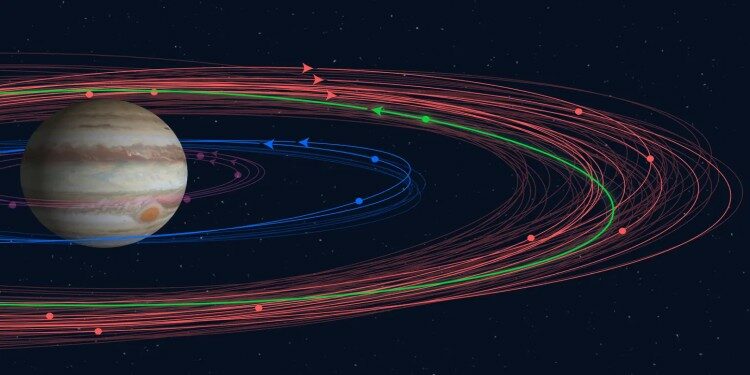Key updates-
- With the latest discovery, the number of moons around the orbit of Jupiter is more than any other planet in our solar system.
- Saturn, the one-time leader, comes in second with 83 confirmed moons.
- The dozen new moons were revealed in the observations conducted by astronomer Scott Sheppard from the Carnegie Institution for Science in Washington.
- The Jupiter moons were added recently to a list kept by the International Astronomical Union’s Minor Planet Centre.
- They were discovered using telescopes in Hawaii and Chile in 2021 and 2022, and their orbits were confirmed with follow-up observations.
- These newest moons range in size from 0.6 miles to 2 miles (1 kilometer to 3 kilometers).
- The newly discovered moons are small and far out with their orbits stretching over 340 days. Meanwhile, nine of the 12 are among the 71 outermost Jovian moons, whose orbits are more than 550 days.
- Jupiter and Saturn are loaded with small moons, believed to be fragments of once bigger moons that collided with one another or with comets or asteroids.
- The same goes for Uranus and Neptune, but they’re so distant that it makes moon-spotting even harder.
- For the record, Uranus has 27 confirmed moons, Neptune 14, Mars two and Earth one. Venus and Mercury come up empty.
About Jupiter-
- Jupiter is the largest planet in the solar system.
- Jupiter is so large that all of the other planets in the solar system could fit inside it. More than 1,300 Earths would fit inside Jupiter.
- It is the fifth planet from the sun and its average distance from the sun is 5.2 astronomical units, or AU.
- When viewed from Earth, Jupiter is usually the second brightest planet in the night sky, after Venus.
- The planet is named after Jupiter, the king of the Roman gods in mythology.
- It is also called a gas giant planet and its atmosphere is made up of mostly hydrogen gas and helium gas, like the sun.
- The planet is covered in thick red, brown, yellow and white clouds and the clouds make the planet look like it has stripes.
- One of Jupiter’s most famous features is the Great Red Spot, a giant spinning storm, resembling a hurricane.
- It rotates, or spins, faster than any other planet.
- One rotation equals one day and Jupiter’s day is only about 10 hours long.
- Its orbit around the sun is elliptical, or oval-shaped.
- Jupiter takes 12 Earth years to make one revolution around the sun, so one year on Jupiter is equal to 12 years on Earth.
- The planet’s four largest moons are Ganymede, Callisto, Io (eye-OH), and Europa.
- Ganymede is the largest moon in the solar system and is larger than the planet Mercury and three-fourths the size of Mars.
- Ganymede is the only moon in the solar system known to have its own magnetic field.
- Ganymede and Callisto have many craters and appear to be made of ice and rocky material.
These four moons are called the Galilean satellites as Italian astronomer Galileo Galilei discovered these moons in 1610
















